Overview of available technologies and clarification of parameters
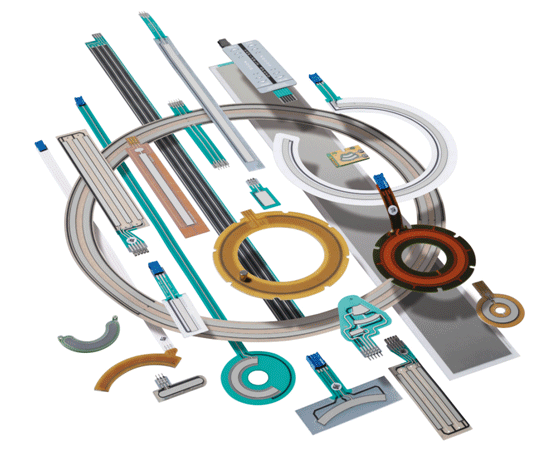
Sensing potentiometers are often used in the design & development of solutions for industrial automation, medical equipment and devices, automotive R&D, forklifts, industrial doors, high end kitchen appliances and hand held tools like power tools. Potentiometers provide highly precise sensing and measurement for linear or rotary movement.
In today’s market, there are a variety of available types of position sensing systems. It is important to compare un9+6ique features to application needs in order to find the best fit. This white paper will help make that specification process and comparison a little easier.
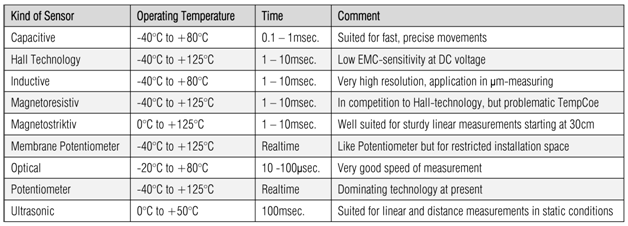
What is a Potentiometer?
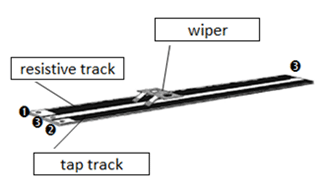
A Potentiometer sensor is an electromechanical component which consists of a resistor where the voltage divider value can be measured at any position by means of sliding contacts between the applied voltage values.
Physically, a potentiometer consists, at a minimum, of a resistance track, a collector track and a sliding contact which can be moved along the resistance track by means of mechanics (the mechanics mostly comprise the housing, the shaft, the slider block, the slider and the bearing). The movement of the sliding contact can be rotatory (angle) or translational (path).
Different types of potentiometer
The available types of potentiometers vary regarding the type of material that is used for the resistance track. Today the three most commonly found materials are carbon and cermet, wire wound and conductive ink.
Carbon- or cermet potentiometer
A chemical mixture of conductive elements consisting of carbon (carbon= air-drying varnish filled with carbon black) or cermet (ceramic-metal) are applied to simple basic carrier as for example laminated paper (FR3 or with cermet – in some cases also ceramic) in silk-screen printing. The life time is very low – just several hundred movements for carbon. In comparison, cermet lasts for much longer – up to 50,000 movements)
Wire-wound Potentiometer
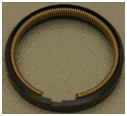 Fine resistance wire is evenly wound on a basic carrier e.g. insulated copper wire. In the early days of potentiometer sensors technology, wire-wound potentiometers were often utilized as big and chunky regulating resistors. In the sixties, the use of fine wire potentiometers became much more common as performance and life time improved – modern wire wound potentiometers provide very good linearity values (0.1% in the voltage divider mode) and the service life of 1 million cycles.
Fine resistance wire is evenly wound on a basic carrier e.g. insulated copper wire. In the early days of potentiometer sensors technology, wire-wound potentiometers were often utilized as big and chunky regulating resistors. In the sixties, the use of fine wire potentiometers became much more common as performance and life time improved – modern wire wound potentiometers provide very good linearity values (0.1% in the voltage divider mode) and the service life of 1 million cycles.
Specialized companies have consistently expanded the development of this technology and are still using it nowadays for research and development, or for small quantities with special qualities.
Conductive plastic potentiometer
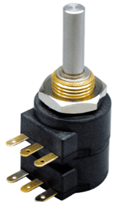 At the end of the Sixties, with the development of high-strength plastics, carbon black sensor components were able to be integrated with a matrix of thermosetting resins. At the beginning of 1980, the German automotive supplier VDO introduced conductive plastic potentiometers into the market for use as an electronic gas pedal.
At the end of the Sixties, with the development of high-strength plastics, carbon black sensor components were able to be integrated with a matrix of thermosetting resins. At the beginning of 1980, the German automotive supplier VDO introduced conductive plastic potentiometers into the market for use as an electronic gas pedal.
Starting in approximately 1982, manufacturers developed a technology to print the conductive plastic directly upon a variety of circuit board materials. FR4 (woven glass and epoxy) is the most common as well as FR2 (phenolic cotton paper), CEM-1 (cotton paper and epoxy) CEM-3 (non-woven glass and epoxy) FR6 (matte glass and polyester) etc. Other suitable circuit board materials include FR1 to FR6, CEM-1 to CEM-5 and G10 (another woven glass with epoxy).
This breakthrough of conductive plastic technology can be used in a wide variety of applications such as accelerator pedals and seat memory function for automobiles, door memory function for hospitals or public buildings, as well as smoke vent status detection, controlled tracking of solar panels, position adjustment of wind turbines and general machine control.
With the increased life cycle compared to wire wound potentiometers, membrane Potentiometers are also useful for industrial machine and system controls as the life time for potentiometers with conductive plastic is 10 to 20 times higher than that of wire wound potentiometers.
This technology is now the first choice for high-grade mass products that require long life and accuracy. In the best case, the accuracy of conductive-plastic potentiometers can be linearized up to 0.05%. The operating life cycles can far exceed 10 million cycles and are often limited only by their associated mechanical parts.
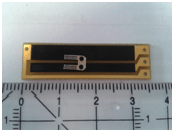
Printed Potentiometers
Printed potentiometers made of polymer pastes can be an integral component of the circuit board for a range of modules and devices. To save space and reduce costs, the potentiometers can be printed directly on the substrate – for example PCB material such as FR4.
Recently, Hoffmann + Krippner developed a unique, innovative technology which enables durable polymer paste (conductive plastic) to be printed on flexible foil. With these printed potentiometers, the voltage dividers – voltage values are taken directly by means of a wiper. A wiper is a metal slider (scraper) that creates a contact between the conductive paths on the foil.
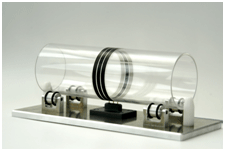
When using a membrane potentiometer to measure a position of a rotating tube, position can be detected on the outside of the tube or from the inside. This enables the sensor to follow any shape and detect a position, given that the wiper always travels within the same distance to the foil. Form factors become less limited with this technology and provide developers and manufacturers with many more options when it comes to designing their products. .
This was previously not possible since the conductive plastic was not flexible or stretchable. Hoffmann + Krippner’s new recipe for the paste makes the paste flexible.
Foil potentiometer (membrane potentiometer)
This is a special form of a potentiometer. It consists of two membranes (foils) separated by a spacer foil: there is a resistance track on the bottom foil and the top foil works as a tap. Compared to the already discussed potentiometric sensors, the membrane potentiometer has one big difference: the collector tap has no direct contact to the resistive track, since it is separated by the spacer foil.
Because of this change of a composition, the customer is able to use any kind of non-electric wiper. Even by slight pressure from a finger, the foil potentiometer can be activated. Another key advantage is the very low sensor height, making them ideal for low profile requirements. This “foil-on-foil” solution can be produced with an IP rating of up to IP65.
This technology can be successfully used for applications with very restricted spaces. Linearity values of up to 0.5% are possible, as well as wide operating temperatures of -40°C to 105°C (-40°F to 220°F).
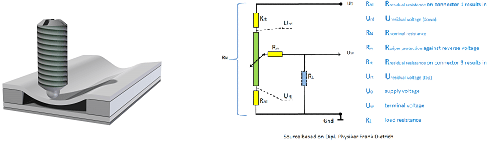
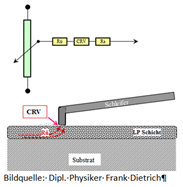
Importance of the Right Wiper
When designing the wiper, it is very important to consider contact resistance, repeatability, hysteresis, the resistive material used, and in particular, the wiper material itself, its shape and the wiper pressure.
Definition of Accuracy
A specific accuracy is often demanded. But there are varying definitions of the term which commonly result in misunderstandings between the user and the manufacturer of application specific potentiometers. Quality criteria including resolution, repeatability and hysteresis all factor into determining a potentiometer’s accuracy as described below.
Resolution is primarily determined by the homogeneity, grain-size distribution within the conductive ink layer, the wiper contact surface running parallel to the equipotential lines, and the wiper current. By approximation, the resolution in regards to resistive tracks will be indicated as infinitely small. In most cases the resolution of the AC/DC converter is much lower than the resolution of the potentiometer itself.
Repeatability is measured by the arbitrary movement towards a predetermined position always approaching from the same direction.
Hysteresis value specifies the signal differential resulting from a predetermined position, approached from one side and then again from the opposite side. Hysteresis is mainly impacted by mechanical factors such as the bearings, the solidity of the wiper system, and the coefficient of friction between the conductive layer and the wiper.
Reproducibility is calculated as the arbitrary approach towards a predetermined position from various directions. It represents the sum of 2x resolution + hysteresis.
Definition of Linearity
Linearity is the deviation of the output characteristic curve as compared to an ideal straight line. It is measured by the greatest deviation from the ideal straight line with respect to the applied voltage. The deviation is given in %.
Essentially three types of nonlinearities can be provided for potentiometer sensor specifications:
- The independent linearity
- The absolute linearity
- The terminal linearity
The required type of linearity and linearity deviation should always be customized for the each specific application. Specifying a percentage of linearity – without further information – automatically implies independent.
SUMMARY
There are a wide range of different sensor applications which require careful consideration and specification of the most effective potentiometer sensor technologies. Once a design engineer has decided that a potentiometer is indeed the most desirable sensing solution for his or her design, they need to carefully examine the sensor’s specs re performance, accuracy, size, IO, temperature range, price etc., etc., etc.
It may be that a certain initial value is required (in R, or U), that a particular performance is required, or it could be that the potentiometer has to have a current or voltage tap, such as Forklifts potentiometer which require a defined center position. Some customers are demanding an absolute accuracy within a certain rotation angle or a path.
In some cases, an existing in stock solution may not exist and the engineer may need to work with the sensor provider to develop a custom solution that meets the needs of that specific project. H + K’s team of engineers is skilled and experienced at working with a customer’s development team to quickly and efficiently developing custom solutions, as well as to provide expertise and assistance with the integration of the sensors into the final product design.
At H + K, a diverse range of precision potentiometers are available in wire, conductive plastic or foil technology, in rotary or linear versions. Many of these potentiometers can be adapted to customer needs. In these cases, it is to the engineer’s benefit to work with an international manufacturing and engineering organization like Hoffman-Krippner with over 30 years of experience designing a wide range of stock and custom sensor solutions. A wide range of input systems, precision potentiometers, filling level sensors, LVDT, Ultrasonic and load cell sensors can be found at http://www.hoffmann-krippner.com.
Author
Jens Kautzor, CEO
Hoffmann + Krippner Inc
2119 Quail Meadow Ln
Frisco, TX 75034
www.hoffmann-krippner.com






